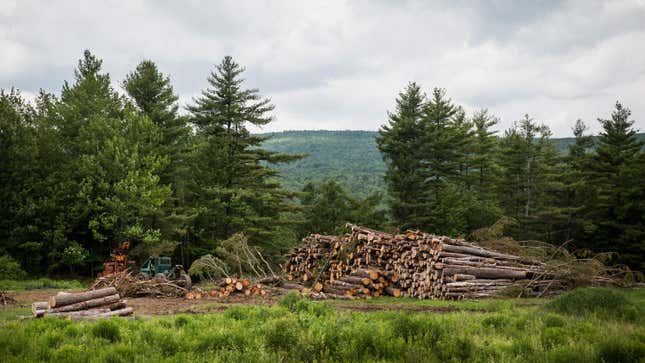
One of the largest timber companies in the world is claiming to “contribute to climate change solutions,” despite the fact that it’s planning to increase lumber production over the next couple of years. As the Wall Street Journal reported on Monday, logging giant Weyerhaeuser has made a pivot in recent years to promoting its timber activities as sustainable and green, a move that follows the drive toward creating profitable carbon offsets from forests—despite the fuzzy math in play.
The key to Weyerhaeuser’s environmental claims is in its forests. Weyerhaeuser currently owns 10.6 million acres of forest in the U.S.—land which can absorb a lot of carbon. Forests like the ones the company owns across the U.S. and Canada are crucial carbon sinks.
The company is cultivating a green image and boasts about its “sustainable forests” on its website. “We use trees to make products people need while taking care of forests for future generations,” the front page copy reads.
As the Wall Street Journal reported, this focus on climate is going along with the market signal: Some big companies are now spending billions on timberland with plans to also use the forests for carbon sequestration. In a bid to attract investors, a new “natural climate solutions” division at the company, the WSJ reported, is designed to help other companies find ways to offset their emissions.
“For large timberland purchases, carbon is an integral part of valuation, just as timber is,” Anton Pil, head of global alternatives for J.P. Morgan Asset Management, told the WSJ.
If you’re thinking it’s weird that Weyerhaeuser gets to claim all those carbon credits when the company is just planning to chop those trees down, you’re not alone. There’s some pretty sticky math involved with justifying labeling for-profit forestry as climate-friendly. (Earther reached out to Weyerhaeuser for comment on the WSJ article and will update this piece if we hear back.)
On the one hand, Weyerhaeuser and other companies say that, because they replant trees after they cut them down, they are helping to maintain and grow that carbon sink. And a table made out of a tree, the company claims, stores carbon more effectively than that same tree would if it fell to the forest floor.
“When we cut and convert trees into wood products, that carbon remains stored for the life of the product,” a Weyerhaeuser pamphlet answering frequently asked questions reads. “And when we replant our forests, those trees start removing more CO2 from the atmosphere.”
While these arguments may look good on paper, there are some serious logical fallacies with how this actually works in real life. One of the key issues here is forest regrowth. Trees, obviously, take time to regrow and get back up to full sequestration strength—Weyerhaeuser can’t just roll out full-size trees to replace the ones it chops down for furniture or Home Depot planks. We don’t have decades to wait for seedlings to regrow and start sequestering carbon, and studies show that logged forests can continue to emit carbon for years after they’re cleared. (Weyerhaeuser told the WSJ it has created new breeds of trees that will grow faster and sequester more carbon than the ones cut down.)
“You never really catch up to what was left in the old growth forest,” Dominick DellaSala, a scientist with environmental nonprofit Earth Island Institute, told reporters last November about these companies’ math. “The carbon debt is transferred to the atmosphere.”
Adding in selling carbon credits to outside companies, as Weyerhaeuser has started to do, creates another layer of complication. Essentially, assuming that the mere existence of forest is a net positive creates a scenario of asking companies to pay Weyerhaeuser to treat an area of forest exactly as it would normally—with those paying companies now getting to write off their own emissions. While some buyers insist on forest owners actually reducing logging, the WSJ reported, that isn’t always the case.
“Most people game the system,” William Sonnenfeld, a forestry consultant, told the WSJ.
And forests aren’t math equations. Trees are complex living organisms, and the actual ability of a forest to store carbon depends on a lot of factors—and can change over time. An investigation into California’s carbon offset program published by ProPublica and MIT Technology Review in 2021 found that almost 30% of the offsets in the program are overvalued, thanks to squishy math and tricks of accounting that don’t take forest variability into account.
Weyerhaeuser’s fuzzy math doesn’t just extend to carbon sequestration. Weyerhaeuser has also heavily pitched the role of biomass—the process of burning woodchips for fuel—as a carbon solution. On the company’s website, biomass is described as “a low-carbon energy solution that also supports jobs in rural communities, keeps forests healthy by protecting them from insects, disease and wildfire, and encourages future sustainable forestry.”
Climate advocates decry biomass’s classification in some countries as carbon-free or green energy: much of the world’s biomass energy is used in Europe, which means wood chips harvested from the U.S. undergo a carbon-intensive voyage to reach their end destination.
It’s not just Weyerhaeuser that is gaming the forestry system. A study published last month in the journal Frontiers in Forests and Global Change that looked at 300 forest carbon offset projects around the world found that many of these projects are “significant[ly] over-crediting” the carbon actually offset by their actions.
Despite the mounting evidence about how carbon accounting can be misused, over-reliance on forests remains a popular choice for polluters who want to keep on pollutin’. Alaska’s governor is currently pushing a bill that would incentivize the state to create a carbon management program for its forests, which the governor has said could bring in “billions” in revenue. As Politico reported on Tuesday, some of the biggest drivers of interest in programs like these are oil companies including ExxonMobil and ConocoPhillips.

